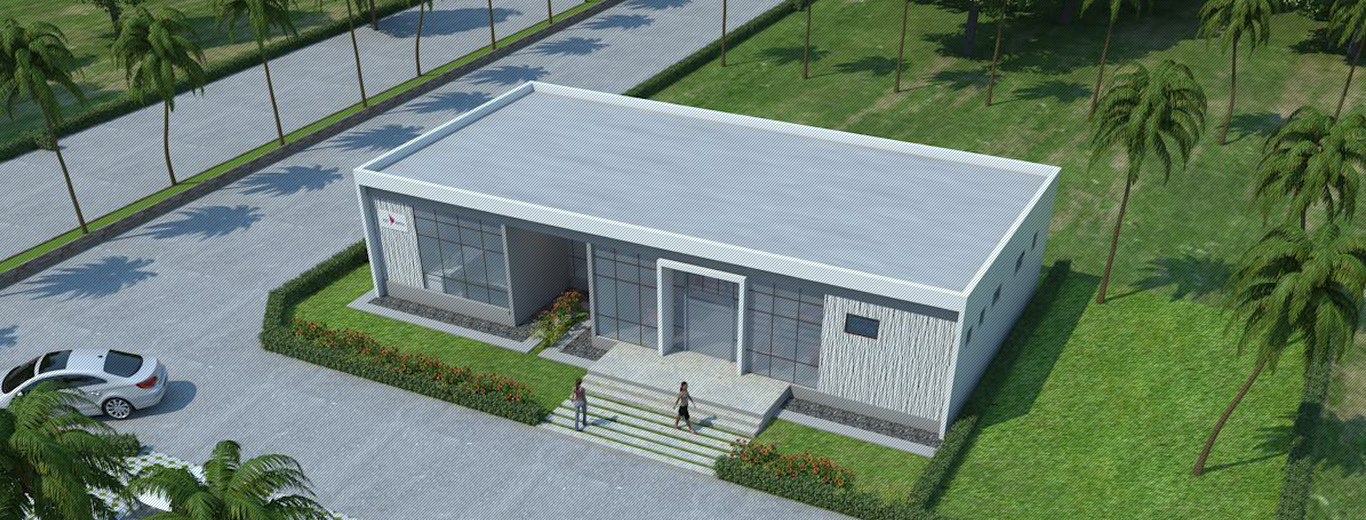The integration of advanced methodologies for inserting vertical and horizontal reinforcements in 3D-printed concrete structures represents a critical frontier in construction technology. Reinforcements, including rebars, meshes, fibers, and composites, can significantly enhance these innovative building components’ structural integrity, strength, and durability. However, their incorporation also introduces complex challenges related to material compatibility, cost considerations, and construction processes.
This article explores the methods employed by different researchers to address these challenges and optimize the use of reinforcements. Additionally, it highlights recent research efforts that introduce novel techniques and technologies, underscoring the ongoing evolution of 3D printing in concrete construction.
Common Methods Used
Some of the common methods used are-
- Rebars: Vertical rebars or tied steel cages can be inserted manually or automatically into the printed layers before they harden. Horizontal rebars can be inserted into pre-drilled holes after the printing process. Using rebars can increase printed concrete structures’ compressive strength, flexural strength, and ductility. However, using rebars can also increase the complexity and cost of the printing process and create weak points or cracks in the printed layers.
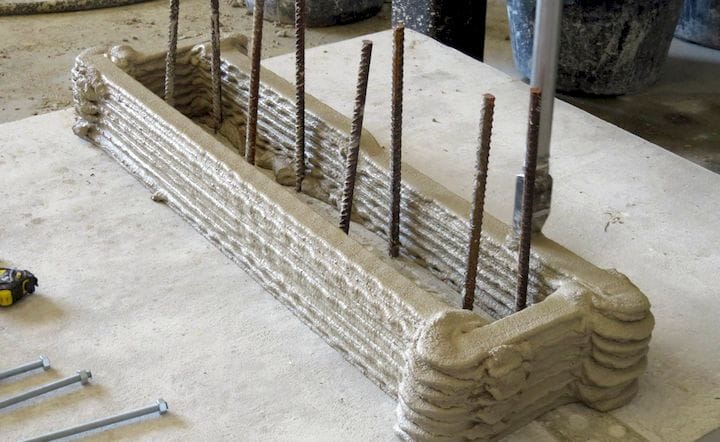
Fig 1: Rebars for 3D Printed Concrete
Courtesy: Fabbaloo
- Meshes: Wire or welded meshes can be placed on top of each printed layer before they harden. Meshes can improve the printed concrete structures’ tensile strength, crack resistance, and durability. However, using meshes can also reduce the flowability and workability of the concrete mixture and create difficulties in aligning and fixing the meshes during the printing process.
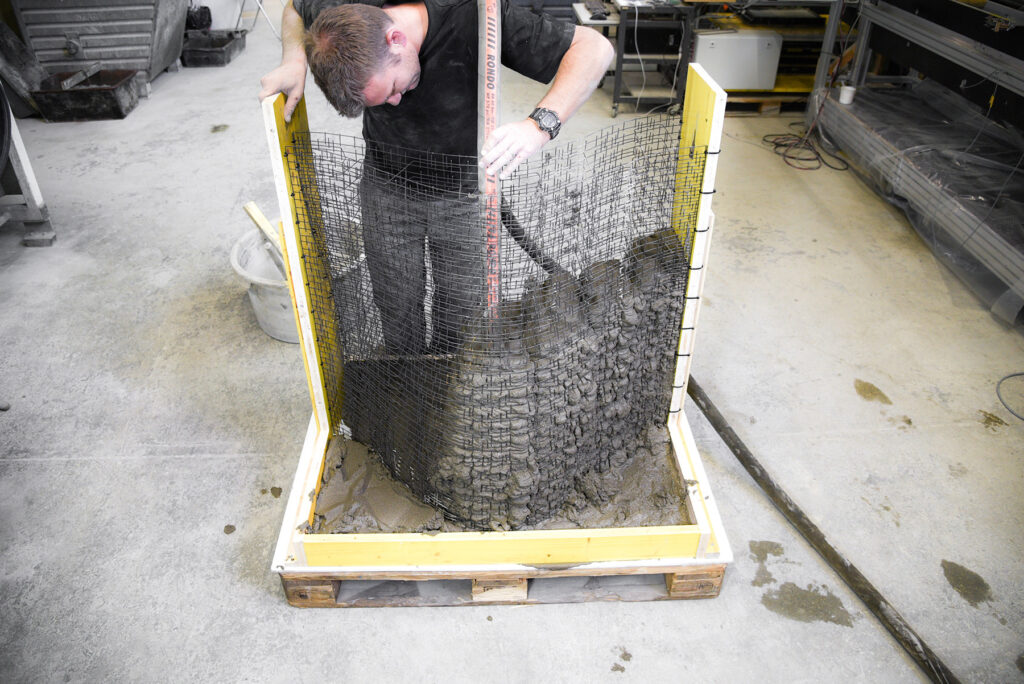
Fig 2: Meshes for 3D Printed Concrete
Courtesy: 3D Printing Industry
- Fibers: Steel, glass, polypropylene, or basalt fibers can be added to the concrete mixture before or during the printing process. Using fibers can enhance printed concrete structures’ toughness, fracture resistance, fire resistance, and shrinkage control. However, using fibers can also affect the rheology and viscosity of the concrete mixture and require special mixing and extrusion equipment to prevent clogging or segregation.
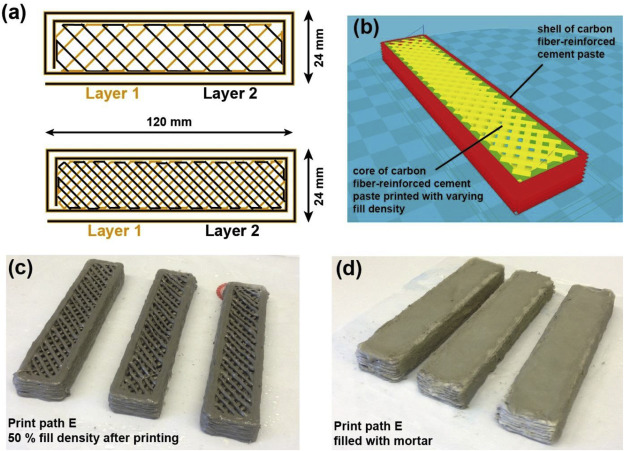
Fig 3: Fibers for 3D Printed Concrete
Courtesy: Hambach and Volkmer 2017
- Composites: Carbon fiber-reinforced polymers (CFRP), glass fiber-reinforced polymers (GFRP), or basalt fiber-reinforced polymers (BFRP) can be used as external or internal reinforcement for printed concrete structures. Composites can provide a high strength-to-weight ratio, corrosion resistance, and fatigue resistance for printed concrete structures. However, using composites can also increase the cost and complexity of the printing process and require special bonding techniques to ensure good adhesion between the composites and the concrete.
New Research Methods for Rebars in 3D Printed Concrete Structures
Some of the new research methods discovered are:
-
Piling and pressing: towards a method of 3D printing reinforced concrete columns by Cohen and Carlson, 2020
The paper introduces a “piling and pressing” method for 3D printing reinforced concrete columns. The method aims to improve the applicability of 3D-printed concrete in architectural construction.
The piling and pressing method involves stacking layers of concrete into a rebar cage. A custom-formed steel plate is then used to press the concrete into place, ensuring proper compaction and consolidation. This process helps enhance the printed columns’ structural integrity and strength. To implement this method, the researchers designed and constructed a printing system. The system includes a progressive cavity pump to extrude the concrete material and an electronic winch for vertical movement. These components enable precise control over the printing process, ensuring accurate placement of the concrete layers.

Fig 4: The stacks of 3D-printed concrete points could not scale without reinforcement
Courtesy: Cohen and Carlson, 2020
The paper discusses the printing process’s concrete mix design and timing parameters. The researchers experimented with different mix designs to optimize the workability and mechanical properties of the printed concrete. They also determined the appropriate timing for pressing each layer to achieve the desired compaction and consolidation. A full-scale test of the piling and pressing method was conducted to validate its effectiveness. The results showed that the printed columns exhibited satisfactory structural performance and met the required strength criteria.
-
State of the Art Review of Reinforcement Strategies and Technologies for 3D Printing of Concrete by Wu et al., 2022
The document discusses the challenges and advancements in reinforcing 3D printed concrete (3DPC) structures. It categorizes the reinforcement methods based on the material used (steel, thermoplastic, FRP, etc.) and the stage at which the reinforcement is placed (pre-installed, in-process, and post-installed reinforcement).
One of the major concrete printing techniques is Contour Crafting (CC), which involves printing the concrete shell as the formwork and then casting the concrete in the core. Vertical rebars or tied steel meshes can be combined with the CC printing method by installing them inside the printed formwork before concrete casting. Horizontal rebars and form ties can be manually laid between layers or inserted into printed layers during printing.
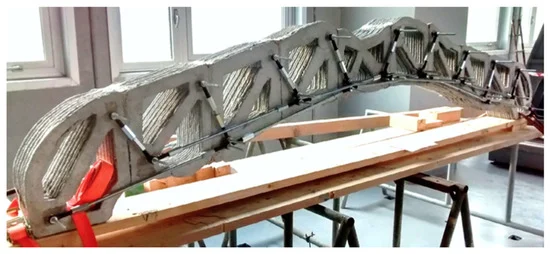
Fig 5: Printed hollow concrete units assembled and reinforced by external steel rebars
Courtesy: Wu et al., 2022
Companies such as Contour Crafting Corp., ICON, TotalKustom, WinSun, CyBe, and Apis Cor have adopted the CC printing method with various reinforcement strategies. This method has been used to print stay-in-place “formwork” for vertical concrete components like walls and columns. However, it has limitations when dealing with walls with vertical curvature.
Another approach is the Mesh Mould concept developed at ETH Zurich, which uses three-dimensional mesh structures to reinforce concrete. Concrete is sprayed over a perforated formwork made of polymer or steel bars. This method provides greater design freedom but requires additional time and labor.
-
Mesh reinforcing method for 3D Concrete Printing by Marchment and Sanjayan 2020
The paper provides in-depth technical information on various aspects of 3D concrete printing (3DcP). One important aspect discussed is the limitations and obstacles in 3DcP, including the need for flowable yet stiff material, the adverse effect of interfaces on bond strength, and the lack of effective reinforcement in the interlayer direction. The paper also presents equations based on three-point bending tests to calculate the flexural moment strength in 3DcP specimens.
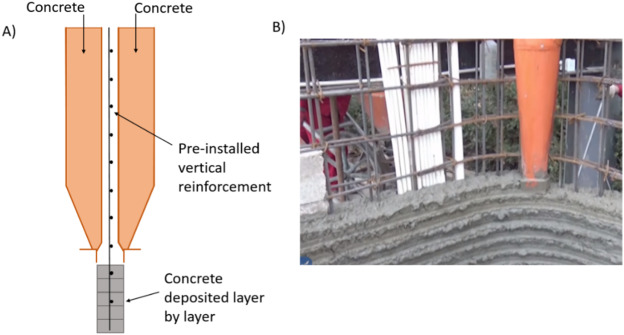
Fig 6: A) Schematic of the pre-installed and B) a photo of the pre-installed reinforcement method
Courtesy: Marchment and Sanjayan 2020
Furthermore, the paper highlights the benefits of 3DcP technology, such as formwork-free construction, enhanced design freedom, reduced material wastage, in-situ construction, and increased safety. It explains that the extrusion 3DcP process involves the controlled extrusion of a stiff, visco-plastic print material layer by layer, similar to fused deposition modeling. The lap length ratio (α) in 3DcP is discussed, suggesting that it should be greater than 0 to ensure continuity but not exceed 1 to avoid nozzle problems. The paper also introduces an innovative nozzle design that allows continuous reinforcing mesh insertion within the extruded print material layer.
Conclusion
In conclusion, the insertion of vertical and horizontal reinforcements, such as rebars, meshes, fibers, and composites, plays a pivotal role in enhancing the structural performance of 3D-printed concrete structures. While each method offers unique advantages in strength, durability, and design freedom, they also present challenges such as increased complexity and cost. Recent research has introduced innovative techniques like the “piling and pressing” method and using three-dimensional mesh structures to address these challenges. These advancements signify the ongoing evolution of 3D printing technology for concrete construction, focusing on improving structural integrity, workability, and overall feasibility. As this field continues to develop, it holds the potential to revolutionize the construction industry by enabling faster, more efficient, and sustainable building processes.

